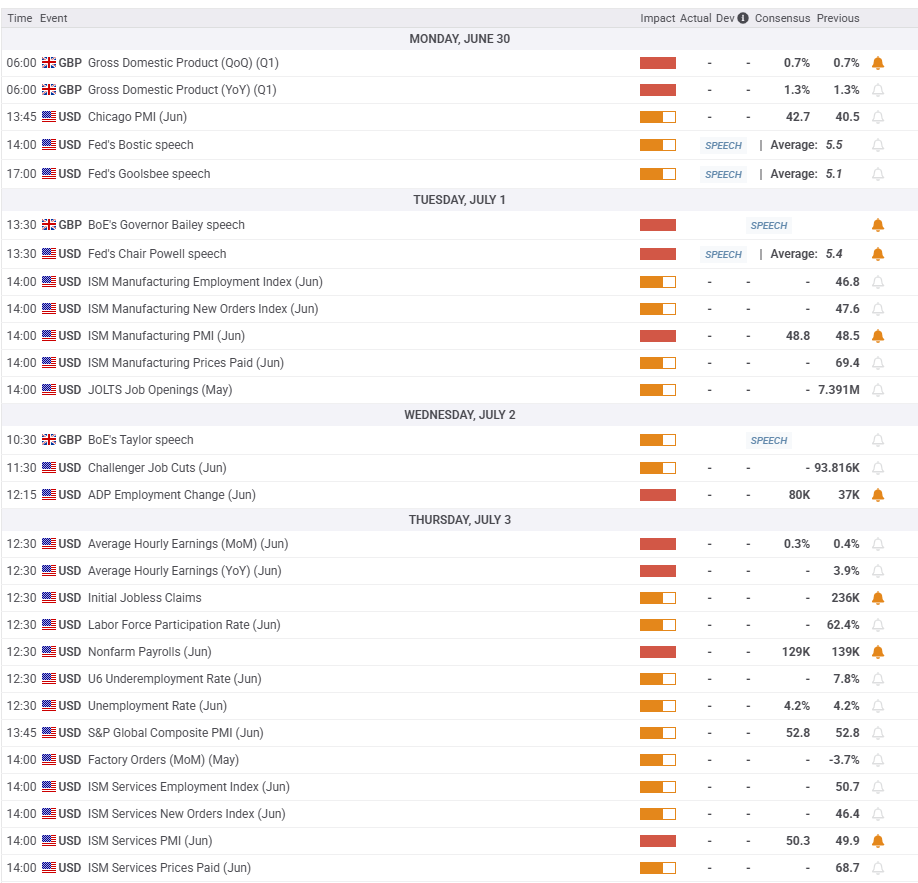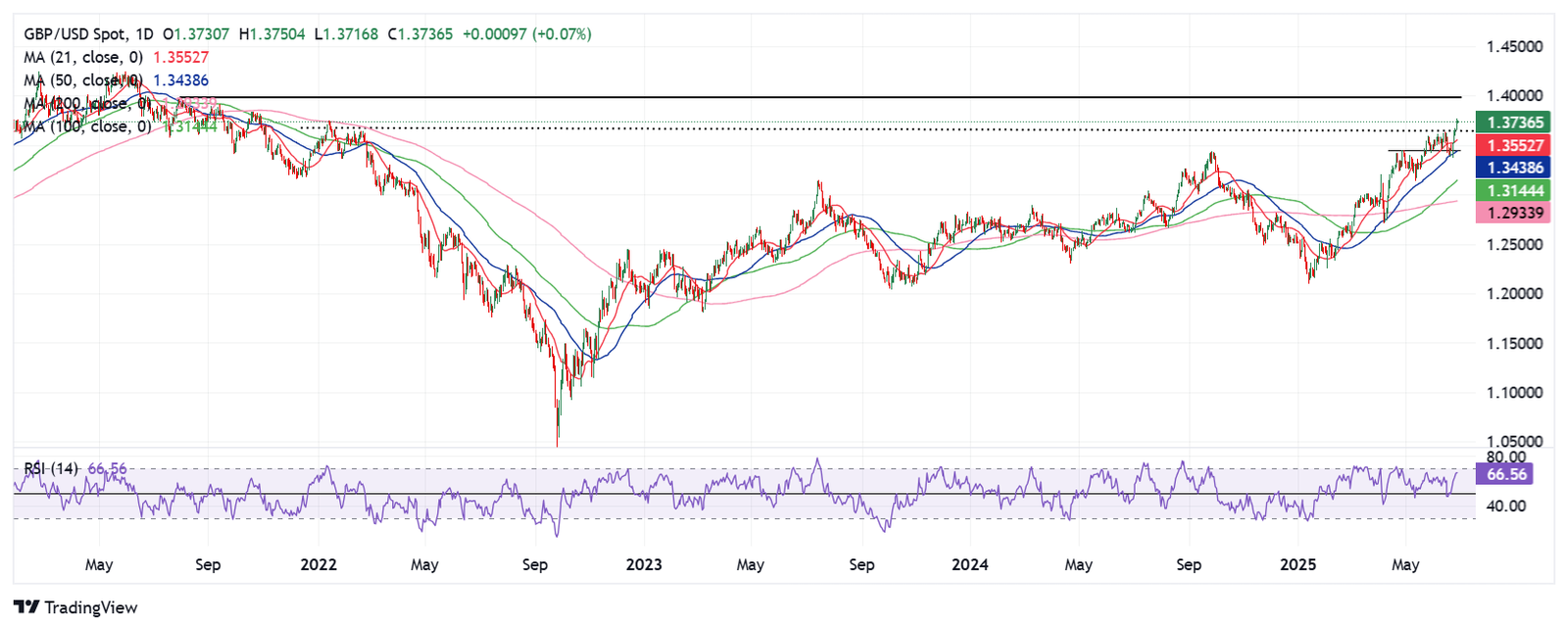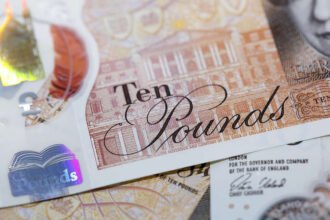- The Pound Sterling rebounded firmly to hit over three-year highs against the US Dollar.
- GBP/USD traders await speeches from Powell and Bailey ahead of the US Nonfarm Payrolls.
- The daily technical setup suggests further upside for the GBP/USD pair.
The Pound Sterling (GBP) recovery gathered steam against the US Dollar (USD), driving the GBP/USD pair to the highest level since October 2021, above 1.3750.
Pound Sterling buyers remained in command
It was a clear win-win case for the higher-yielding Pound Sterling as the US Dollar gradually lost its safe-haven appeal amid yo-yo-ing sentiment surrounding the US Federal Reserve’s policy outlook.
Though the GBP/USD pair saw a bearish opening gap on Monday, it was quickly reversed as buyers jumped back with a bang.
The Pound Sterling was sold off at the weekly open as investors scurried for safety in the US Dollar after markets reacted negatively to the weekend news of the US military involvement in the Israel-Iran conflict.
Early Sunday, US President Donald Trump announced that the United States (US) carried out airstrikes on three of Iran’s most critical nuclear sites, Fordow, Natanz and Isfahan.
In response, Supreme Leader Ayatollah Khamenei warned that American involvement would bring “irreparable damage,” raising concerns that the Israel-Iran conflict would translate into a wider Middle East regional war.
However, the Greenback’s safe-haven appeal fizzled out, following the Iran-Israel ceasefire announcement by US President Donald Trump and later by Iranian Foreign Minister Abbas Araghchi late Monday.
Reviving expectations surrounding a Fed interest rate cut in July exerted additional downward pressure on US currency, helping the pair stage a solid turnaround.
These expectations were prompted by Fed Governor Michelle Bowman and her colleague Christopher Waller, who advocated the next rate cut as early as July.
Markets are currently pricing in a 21% chance of a July Fed rate cut, while for a September reduction, the odds stand at 75%, the CME Group’s FedWatch Tool showed.
On Tuesday, the Greenback briefly drew support from Fed Chair Powell’s testimony before the House Financial Committee, but the Middle East de-escalation overshadowed and continued to boost risk appetite.
Risk flows drove US stocks higher, diminishing the USD’s status as a safe haven.
Powell said he expects policymakers to stay on hold until they have better clarity on the impact tariffs will have on prices. “We’re just trying to be careful and cautious,” he noted.
The USD’s declines gathered strength, and it hit over three-year highs against its major currency rivals in the aftermath of US President Donald Trump’s fresh attack on the Federal Reserve’s (Fed) credibility.
Citing some sources, the Wall Street Journal (WSJ) reported early Thursday that President Trump is considering selecting and announcing a successor for Fed Chair Jerome Powell by September or October.
The unabated US Dollar selling drove the pair to three-and-a-half-year highs of 1.3771 on Thursday. However, USD buyers quickly returned at lower levels after a person familiar with the White House’s deliberations told Reuters on Thursday, “Trump has not decided on a replacement for Powell and a decision is not imminent.”
Moreover, hopes of US trade deals with the European Union (EU) and China before the July 9 deadline helped the US Dollar cut some of its weekly losses early Friday.
A WSJ report cited late Thursday that EU officials are weighing lowering tariffs on US imports to woo Trump.
Meanwhile, a White House official said that the US has reached an understanding with China on how to expedite rare earth shipments to the US. In the American session on Friday, the data published by the US Bureau of Economic Analysis showed that the core Personal Consumption Expenditures (PCE) Price Index, the Fed’s preferred gauge of inflation, rose 2.7% on a yearly basis in May. This reading came in above the market expectation and April’s increase of 2.6% and helped the USD limit its losses, making it difficult for GBP/USD to extend its rally heading into the weekend.
A Big week to watch out for
It’s a critical week, though holiday-shortened, filled with a flurry of high-impact economic data from the United States (US) and central banks’ talks.
The week begins with China’s official Manufacturing and Non-Manufacturing PMI readings on Monday, which could set the tone for markets, significantly impacting risk sentiment.
The US and the UK dockets are data-dry on Monday, and hence, the attention turns to Tuesday’s US JOLTS Job Openings Survey and the ISM Manufacturing PMI.
However, the main event risks that day would be the speeches from BoE Governor Bailey and Fed Chair Powell as they participate in a panel discussion titled “Policy panel” at the two-day European Central Bank (ECB) Forum on Central Banking, in Sintra.
These commentaries could overshadow the impact of the US data releases on Tuesday, stirring volatility around the USD, in turn, the GBP/USD pair.
Wednesday will feature the US ADP Employment Change report for June, followed by an action-packed American calendar on Thursday, as markets will observe Independence Day on Friday, July 4.
All eyes will remain on the US Nonfarm Payrolls data for June alongside the releases of the Jobless Claims, Trade Balance, and the ISM Services PMI data.
Markets will continue to monitor the developments on the trade front and geopolitical updates from the Middle East conflict.

GBP/USD: Technical Outlook

GBP/USD defended the critical 50-day Simple Moving Average (SMA) support, then at 1.3402, and surpassed two major resistance levels on its way to multi-month highs at 1.3771.
In the upcoming week, the pair remains poised for more upside as long as the 14-day Relative Strength Index (RSI) holds comfortable in the bullish territory.
The leading indicator currently sits just beneath the overbought zone, supporting the bullish bias.
If the RSI enters the overbought region above the 70 level, the pair could see a brief correction toward the previous resistance-turned-support of the February 2022 high at 1.3643.
The 21-day SMA at 1.3552 could challenge the bullish commitments if the pullback gains traction.
Additional declines will likely attack the 1.3445 demand zone, which is the confluence of the April 28 high and the 50-day SMA.
On the other hand, if the buying interest remains unabated, GBP/USD could take on the 1.3800 round level, above which the static resistance around 1.3875 will come into play.
Further north, buyers will target the July 30 high of 1.3983.
Pound Sterling FAQs
The Pound Sterling (GBP) is the oldest currency in the world (886 AD) and the official currency of the United Kingdom. It is the fourth most traded unit for foreign exchange (FX) in the world, accounting for 12% of all transactions, averaging $630 billion a day, according to 2022 data.
Its key trading pairs are GBP/USD, also known as ‘Cable’, which accounts for 11% of FX, GBP/JPY, or the ‘Dragon’ as it is known by traders (3%), and EUR/GBP (2%). The Pound Sterling is issued by the Bank of England (BoE).
The single most important factor influencing the value of the Pound Sterling is monetary policy decided by the Bank of England. The BoE bases its decisions on whether it has achieved its primary goal of “price stability” – a steady inflation rate of around 2%. Its primary tool for achieving this is the adjustment of interest rates.
When inflation is too high, the BoE will try to rein it in by raising interest rates, making it more expensive for people and businesses to access credit. This is generally positive for GBP, as higher interest rates make the UK a more attractive place for global investors to park their money.
When inflation falls too low it is a sign economic growth is slowing. In this scenario, the BoE will consider lowering interest rates to cheapen credit so businesses will borrow more to invest in growth-generating projects.
Data releases gauge the health of the economy and can impact the value of the Pound Sterling. Indicators such as GDP, Manufacturing and Services PMIs, and employment can all influence the direction of the GBP.
A strong economy is good for Sterling. Not only does it attract more foreign investment but it may encourage the BoE to put up interest rates, which will directly strengthen GBP. Otherwise, if economic data is weak, the Pound Sterling is likely to fall.
Another significant data release for the Pound Sterling is the Trade Balance. This indicator measures the difference between what a country earns from its exports and what it spends on imports over a given period.
If a country produces highly sought-after exports, its currency will benefit purely from the extra demand created from foreign buyers seeking to purchase these goods. Therefore, a positive net Trade Balance strengthens a currency and vice versa for a negative balance.





















